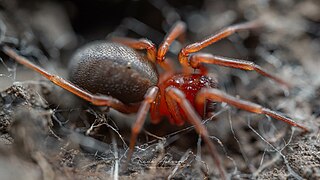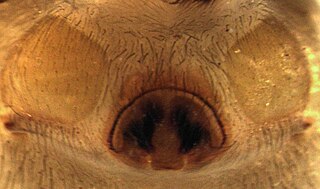
Huttoniidae is a family of ecribellate araneomorph spiders containing a single genus, Huttonia, itself containing a single described species, Huttonia palpimanoides. It is known only from New Zealand.

Gradungulidae, also known as large-clawed spiders, is a spider family endemic to Australia and New Zealand. They are medium to large-sized haplogyne spiders with three claws and two pairs of book-lungs similar to Mygalomorphae. Some species build extensive webs with an upper retreat tangle and connecting threads to scaffolding. This supports the ladder-like catching platform that is glued to the ground. Progradungula, a large spider with long legs like Hickmania, and Macrogradungula are the only cribellate genera of the family.

Periegops is a genus of spiders with six eyes instead of the usual eight. It is the only genus in its family (Periegopidae) and has three described species. It was long considered to be a member of Sicariidae or Segestriidae until Raymond Forster elevated it to the family level in 1995.

Orsolobidae is a six-eyed spider family with about 180 described species in thirty genera. It was first described by J. A. L. Cooke in 1965, and was raised to family status from "Dysderidae" in 1985.

Stiphidiidae, also called sheetweb spiders, is a family of araneomorph spiders first described in 1917. Most species are medium size and speckled brown with long legs. All members of this family occur in New Zealand and Australia except for Asmea. They build a horizontal sheet-like web under rocks, hence the name "sheetweb spiders".
Wiltonia is a genus of Polynesian araneomorph spiders in the family Orsolobidae, and was first described by Raymond Robert Forster & Norman I. Platnick in 1985.
Makora is a genus of South Pacific intertidal spiders first described by Raymond Robert Forster & C. L. Wilton in 1973.

Cycloctenus is a genus of Australasian araneomorph spiders in the family Cycloctenidae, first described by L. Koch in 1878. Originally placed with the nursery web spiders, it was transferred to the family Toxopidae because of the distinctive arrangement of its eyes, particularly the enlarged posterolateral eyes. It was moved to the Cycloctenidae in 1967.

Toxopsiella is a genus of South Pacific araneomorph spiders in the family Cycloctenidae, and was first described by Raymond Robert Forster in 1964.
Hapona is a genus of South Pacific araneomorph spiders in the family Toxopidae, and was first described by Raymond Robert Forster in 1970. Originally placed with the intertidal spiders, it was moved to the Toxopidae in 2017.

Kapanga is a genus of South Pacific dwarf sheet spiders that was first described by Raymond Robert Forster in 1970.

Hypodrassodes is a genus of South Pacific ground spiders that was first described by R. de Dalmas in 1919.

Intruda is a monotypic genus of South Pacific ground spiders containing the single species, Intruda signata. It was first described by Raymond Robert Forster in 1979, and has only been found in Australia and in New Zealand.

Kaitawa is a monotypic genus of South Pacific ground spiders containing the single species, Kaitawa insulare. It was first described by Raymond Robert Forster in 1979, who separated Cheiracanthium insulare from Cheiracanthium into this genus, retaining the species name. It has only been found in New Zealand.

Zelanda is a genus of South Pacific ground spiders that was first described by H. Özdikmen in 2009.

Ascuta is a genus of araneomorph spiders endemic to New Zealand in the family Orsolobidae, and was first described by Raymond Robert Forster in 1956.
Subantarctia is a genus of Polynesian araneomorph spiders in the family Orsolobidae, first described by Raymond Robert Forster in 1955.

Physoglenidae is a family of araneomorph spiders first described by Alexander Petrunkevitch in 1928 as a subfamily of Pholcidae. It was later moved to Synotaxidae until a study in 2016 showed that they formed a distinct clade.

Toxopidae is a small family of araneomorph spiders, first described in 1940. For many years it was sunk into Desidae as a subfamily, although doubts were expressed as to whether this was correct. A large-scale molecular phylogenetic study in 2016 led to the family being revived.
Matua is a genus of South Pacific ground spiders that was first described by Raymond Robert Forster in 1979. As of May 2019 it contains only two species, both found in New Zealand: M. festiva and M. valida.















